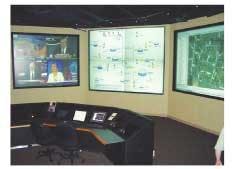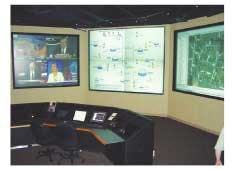MURFREESBORO, Tenn. -Officials at Tennessee’s largest rural water utility district, Consolidated Utility District of Rutherford County (CUDRC), needed to secure the public water supply against intrusion and contamination. CUDRC leaders executed an infrastructure security plan using state-of-the-art technology from RGB Spectrum in Alameda, Calif.
The core of the plan was the design and construction of a centralized command center operating 24 hours a day to continuously monitor the utility’s water reservoirs, pump stations, flow meters, pressure zones, storage tanks, and distribution lines, RGB Spectrum officials say. The new security command center uses RGB Spectrum’s Quadra and QuadView multiple image display systems for around-the-clock monitoring.
RGB Spectrum’s Quadra multisignal processor is used to create a massive display array on the command center’s main screen. The Quadra displays a graphical depiction of CUDRC’s entire water storage and distribution system for real-time monitoring.
CUDRC contracted with audio-visual system integrator Multi-Media Solutions in Alcoa, Tenn., to design and construct the audio/visual display system in the new command center. “The goal of the new security and monitoring command center is to enable personnel to know everything occurring system-wide by displaying all the surveillance and data components throughout the entire system on a central video wall,” says Larry McElroy, general manager for CUDRC explains.
“The challenge was to integrate a myriad of incoming data and visuals of varying types,” says Mike White, president and chief executive officer of Multi-Media Solutions. “The system specifications required true real-time display of all signals and the ability to manipulate the size and position of these images on the screens. We designed a wall-sized display system composed of three rear projection screens. The left and right screens are 7.5 by 10 feet. The center screen dimension is 9.5 by 12 feet. We incorporated RGB Spectrum’s state-of-the-art Quadra multiscreen and QuadView multi-image display processors to give CUDRC staff the ability to view all of the system-wide visuals and data simultaneously on the video wall.”
The Quadra receives four high-resolution computer inputs from a matrix switcher connected to six computers and four video sources. The Quadra concurrently outputs these four images to four rear screen projectors on the center screen. The Quadra’s “wall” function is enabled to display a two-by-two array on the screen, creating a massive, composite image. The center wall images consist of a system-wide map, topographic map, or flow chart depicting pumping stations. The most frequently used image is the system-wide map which depicts every reservoir, distribution pipe, valve, pump station, pressure monitoring station, water meter, and service vehicle. The security center’s computers continuously receive live status data from transducers throughout the system and Global Positioning Systems (GPS) transmissions from the service vehicles, which are fed into a computer program that generates easily understood visuals. The Quadra displays the updated visuals for real-time monitoring of reservoir levels, flow production, operating pressure, and resource deployment.
The right screen is used to monitor live video surveillance. The system supports as many as 32 IP-based video surveillance cameras positioned at critical perimeter detection points at the reservoirs and pump stations. The cameras’ signals are converted via MPEG PC-boards to RGB analog signals. The QuadView receives any four of these camera feeds at a time and outputs them to a rear screen projector, RGB Spectrum officials say.
The left screen displays feeds from weather stations and local television broadcasts. Frigid temperatures, high winds, thunderstorms, and tornadoes can damage the water distribution systems, so weather conditions are continuously monitored. The QuadView processor is fed as many as four live video signals from satellite and local cable television sources and sends them to the rear screen projector for simultaneous display.
The wall-size display system uses six Christie Digital Systems DS-30 rear-projection DLP projectors, four in the two-by-two array center screen and one each in the left and right screens. The Quadra and QuadView processors output to these projectors in their native 1280-by-1024 resolution. Command-center operators select desired inputs, switch image feeds, and control the display configurations for all three screens using a simple preprogrammed touch- screen controller situated on the main console.
“The Quadra and QuadView processors give CUDRC personnel the powerful display versatility they needed in this mission-critical environment,” White says. “Personnel can view any visual and data point system-wide in real-time. Operators can resize, zoom, and pan any image for greater detail and to focus on a particular area. The processors deliver exceptional image quality with sharp, crisp display of the high-resolution graphics.”
“The district’s entire distribution system can be monitored and controlled, and coordinated by a single person,” McElroy says. “Our personnel have the ability to assess and respond to critical situations and needs as they arise. We can respond to system defects, disruptions, damage, and incidents more quickly and effectively. If an intrusion is detected, the center operator can immediately turn off the pumps to prevent potentially contaminated water from being distributed. The center’s innovative display capabilities gives us a quantum leap in preparedness, situational awareness, resource coordination efficiency, and response capability.”
For more on RGB Spectrum go online at www.rgb.com.



